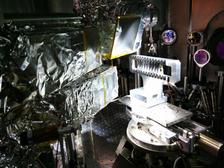Experimental set-up at the X-ray laser LCLS at SLAC National Accelerator Laboratory. (Credit: DESY, Emma McBride)
Silicon is one of the most abundant elements in nature and is used for many technical applications such as solar cells or microchips. The international team that included scientists from DESY and Europe's new X-ray laser European XFEL conducted the experiments at the Linac Coherent Light Source at SLAC National Laboratory in the US. Some properties of the semimetal have not been examined in detail yet. Using a new experimental geometry, researchers have now investigated systematically how silicon reacts to rapid compression. The results are presented in the scientific journal Nature Physics.
When scientists want to find out more about processes and materials in the interior of planets, they often try to imitate the conditions that prevail under the surface in the laboratory. For that, they have to generate simultaneous high pressures and high temperatures. There are different methods to produce the necessary pressure that differ in their compression rates. If the pressure is changed slowly, it is called static compression, at higher rates scientists speak of dynamic compression. While experiments conducted under static compression in so-called Diamond Anvil Cells (DACs) are better suited to replicate the conditions in the interior of smaller planets like Earth, pressure and temperature regimes of very large exoplanets – the planets of other stars – cannot yet be simulated in a DAC. Thus, experiments using dynamic compression are needed to create very high temperatures and simultaneously high pressures to explore very large planets.
One possibility to compress materials very rapidly is through so-called laser-driven shock compression. “In our experiment we use a strong laser to compress the sample. The laser is guided onto a very small area of the material so we reach a very high intensity,” explains Emma McBride, first author of the study. “The laser generates a plasma, which expands outwards from the surface of the target. As a consequence of conservation of mass and momentum, a wave forms in the opposite direction, compressing the sample.”
There also is a drawback when using shock compression in an experiment. Results of the measurements can be quite inexact in some cases. For silicon, its properties at static compression are well known, but there is no clear consensus on the structural changes in the material that are caused by rapid compression. “The reason is that we did not have the necessary tools to measure the structure exactly for a long time. We need short X-ray pulses with very high brightness,” says DESY scientist Sven Toleikis, a co-author of the study. “It’s only since a few years that free electron lasers like the European XFEL and the LCLS allow us to analyse the changes occurring during shock compression in detail, to the level of the lattice of atoms or molecules.” However, even with the advanced instruments, it is difficult to identify complex processes in materials where different structures exist at the same time.
Using a new experimental geometry, the team headed by McBride was able to observe the different transformations that silicon goes through during shock compression. They positioned the compression laser perpendicular to the X-ray source. In earlier experiments, both were placed almost parallel to each other. The new results show that many assumptions about the transformations in silicon were incorrect. For example, above a certain pressure the scientists observed melting of silicon. In earlier studies, it was assumed that at the detected melting pressure a transformation from one solid structure to another takes place instead of melting. Additionally, solid-solid transformations were observed at much lower pressures than in static compression.
This illustrates another issue in conducting experiments with shock compression. Their results cannot simply be transferred to the static conditions in the interior of planets. “Previous studies suggested that the structure of silicon would transform at higher pressures during shock compression because the material would not have enough time to adapt to the changed conditions under the nanosecond timescales of laser shock compression”, explains McBride, who worked at DESY when the experiments were performed but now works at SLAC. „Our results now show that in the case of silicon the opposite is true. This points to the fact that not all systems behave the same way. There is still a lot of work to do.”
Researchers from DESY and the European XFEL will try to shed light onto this problem as part of a research unit funded by the Deutsche Forschungsgemeinschaft (FOR2440). In future experiments, scientists want to systematically compare measurements from experiments using diamond anvil cells and shock compression. This way, they hope to learn more about how to use shock compression to find out more about the processes in the interior of planets.At the HED (High Energy Density) instrument at the European XFEL the “Helmholtz International Beamline for Extreme Fields (HIBEF)” user consortium is building an experimental setup to conduct shock experiments very similar to those done at the LCSL for this study.
Researchers from SLAC, European XFEL, Helmholtz-Zentrum Dresden-Rossendorf, Lawrence Livermore National Laboratory in the US, the University of Oxford, the University of York and Rutherford Appleton Laboratory in the UK, from the French Institut de Recherche pour le Développement and from DESY contributed to the study.
Reference:
Phase transition lowering in dynamically compressed silicon; E. E. McBride, A. Krygier, A. Ehnes, E. Galtier, M. Harmand, Z. Konôpková, H. J. Lee, H.-P. Liermann, B. Nagler, A. Pelka, M. Rödel, A. Schropp, R. F. Smith, C. Spindloe, D. Swift, F. Tavella, S. Toleikis, T. Tschentscher, J. S. Wark, A. Higginbotham; Nature Physics, 2018; DOI: 10.1038/s41567-018-0290-x







